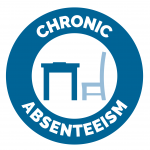 A contributing factor to the lower academic performance of Black students in public schools is greater rates of absenteeism compared to White students. Simply put, if Black students are less likely than White students to be in school, they are less likely to learn and do well on examinations and other assignments. The U.S. Department of Education reports that children who are chronically absent in preschool, kindergarten, and first grade are much less likely to read at grade level by the third grade. Students who cannot read at grade level by the end of third grade are four times more likely than proficient readers to drop out of high school.
A contributing factor to the lower academic performance of Black students in public schools is greater rates of absenteeism compared to White students. Simply put, if Black students are less likely than White students to be in school, they are less likely to learn and do well on examinations and other assignments. The U.S. Department of Education reports that children who are chronically absent in preschool, kindergarten, and first grade are much less likely to read at grade level by the third grade. Students who cannot read at grade level by the end of third grade are four times more likely than proficient readers to drop out of high school.
New data from the California Department of Education sheds light on the racial attendance gap. Data for the 2017-18 and 2018-19 school years (prior to the global pandemic), shows that Black students missed an average of 13.2 days of school each year. White students were absent, on average, for 9.1 school days.
The data shows that for White students 64 percent of absences were “excused.” This means the student was sick or had a reason for missing school that was approved by school administrators. For Black students, only 38.1 percent of absences were excused and 52.7 percent were unexcused. Typically unexcused absences are the result of transportation issues, family concerns such as providing care for younger children so parents can work, safety concerns, truancy, etc. The problem here is that unexcused absences often result in disciplinary actions such as in-school suspensions, which further removes these students from classroom instruction.
Finally, Black students were 2.5 times as likely as White students to be absent as a result of out-of-school suspensions.
Tony Thurmond, State Superintendent of Public Instruction in California, stated that “knowing why students are missing school is a crucial step in helping them stay in school. These data add an extra layer of transparency to existing absenteeism information and a level of detail that school districts can utilize as they evaluate the effectiveness of existing attendance plans and compare absenteeism rates with other districts. It also creates an opportunity for school attendance staff throughout the state to collaborate and share best practices on methods to improve attendance, identifying specific actions that can help students and their families overcome attendance barriers.”










